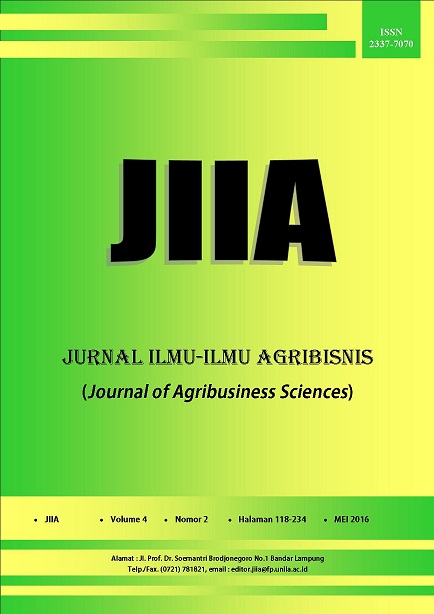DISTRIBUSI PENDAPATAN RUMAH TANGGA DAN KESEJAHTERAAN PETANI SAYUR DI DESA SIMPANG KANAN KECAMATAN SUMBEREJO KABUPATEN TANGGAMUS
DOI:
https://doi.org/10.23960/jiia.v4i2.1231 Abstract View: 1142
Abstract View: 1142
Abstract
This research purposed to analyze household income of vegetable farmer, income distribution ofvegetable farmers and vegetable farmers welfare level in Simpang Kanan Village. Simpang Kanan Village, Sumberejo Sub districts, Tanggamus Regency was selected purposively because of vegetable producer in Lampung Province. The amount of the respondent for this research was 60 vegetable farmers were selected by census from farmers bunch in Simpang Kanan Village. This research was conducted with survey methods from November 2014 to May 2015. Analyze of vegetable farming used Soekartawi (1995), analyze of welfare rate based on Sajogyo (1997) and the income distribution by Gini Ratio based on Oshima and World Bank criteria. The research data was included primary and secondary data. The primary data was obtained by interviewing respondents using questionnaires, while secondary data was obtained by searching various literatures and related agencies. The result of this research showed that farmers household income source composed from several land such as yard farm, paddy field farm, kail yard farm, garden farm and non farming activity. The average worth of each household income source was Rp 53.467.405,31 from farming activity and Rp13.740.000,00 from non farming activity. Income distribution in research area was disproportionate with quite high gap, and farmer’s welfare level in research area was at moderatelevel, with non food expenditure was higher than food expenditure. Percentage of prosperous farmer were 78,33% and the poor farmer were 21,66%. This means that the farmers were prosepere enough in social welfare.
Key words: gini ratio, household income, vegetable farmer, welfare
Downloads
Downloads
Published
How to Cite
Issue
Section
License
Authors who publish with this journal agree to the following terms:
Authors retain copyright and grant the journal right of first publication with the work simultaneously licensed under a Creative Commons Attribution License that allows others to share the work with an acknowledgement of the work's authorship and initial publication in this journal.
Authors are able to enter into separate, additional contractual arrangements for the non-exclusive distribution of the journal's published version of the work (e.g., post it to an institutional repository or publish it in a book), with an acknowledgement of its initial publication in this journal.
Authors are permitted and encouraged to post their work online (e.g., in institutional repositories or on their website) prior to and during the submission process, as it can lead to productive exchanges, as well as earlier and greater citation of published work (See The Effect of Open Access).














